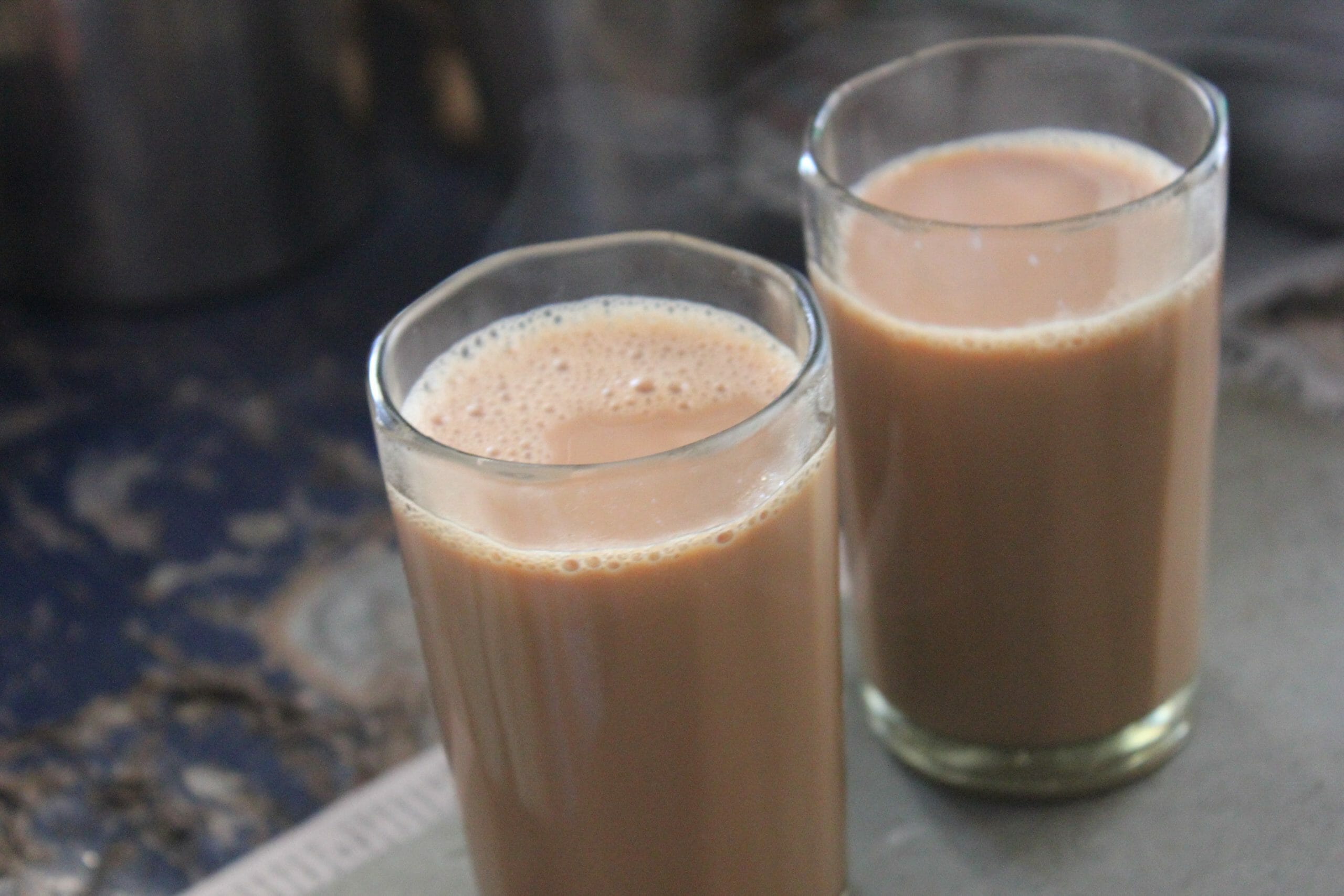Chai means tea. However, in the West the word chai refers to what in India is called Masala Chai. Masala is a mixture of spices. Therefore Masala Chai is black tea brewed with a mix of spices, and most often with cow’s milk, sugar, and of course water. If you ask for chai in India, you will receive black tea with cows milk and a heaping of sugar. No spice.
When brewing up chai in india, the masala of choice varies between the different regions and states within the country. Ayurvedic Chai, on the contrary, is consistently the same as it is based on medicinal principles, with seasonal nuances taken into consideration.
Here I share with you the Ayurvedic Chai recipe which was passed on direct to me from one of my teachers, Dr. Ajit, of the Australasian Institute Of Ayurvedic Studies. Not only will you be able to easily follow this recipe and enjoy the leisurely act of sipping on a homemade brew, here you will also understand the reasons why each element, or ingredient, of the recipe is so essential.
Drinking Masala Chai is drinking up the richness of a spiritual way of life. Savour each sip!
Serves 2
INGREDIENTS:
- 1 cup organic, unhomogenised, full fat cow’s milk
- 1 cup filtered, boiled water
- 3 tsp jaggery or rapadura sugar
- 1 tsp organic loose leaf black tea
- Thumb size piece of freshly grated organic ginger
- 3-5 Green cardamom pods
- Large pinch ajwain seeds
- 1 black cardamom pod
- 1 small cinnamon stick, or 2 tsp of cinnamon chips
- Pinch fennel seeds (late spring – summertime only)
- 3 clove buds (wintertime only)
MATERIALS:
- Small saucepan to brew your chai in
- Fine and small mesh strainer
- Teaspoon
- Spoon for stirring
- Grater (for fresh ginger)
- Your favourite tea cups or mugs
INSTRUCTIONS:
– Boil water in your kettle/jug. Whilst water is boiling, grate fresh ginger into saucepan, and add the rest of your spices.
– Add a cup of boiled water to saucepan, and turn stove on to high heat, bringing spiced water to the boil. Reduce to a simmer. Leave to simmer and brew for a few mins (the longer you leave it the more flavour. However, more water will evaporate, so reduce to low-medium temperature if you wish to leave it for a while).
– Add jaggery (or sugar of choice). Stir through briefly.
– Turn heat to high. Immediately add black tea and milk together at the same time. Stir through.
– Bring to a boil. (Don’t let it overflow!!)
– Take your chai off the heat, and let it sit for a couple of minutes. You could add 1/4 tsp powdered turmeric at this time if you wish – but not essential. Keep stirring occasionally prior to serving, as milk is unhomogenised, and the fats will keep settling.
– Strain directly into your tea mugs, through your fine strainer. Pour patiently so as not to spill!
– Sit down to drink your beautiful and healing Ayurvedic masala chai. Breath in the sweet scent and sip slowly.

NOTES:
>> In late Winter and early Spring, replace fresh ginger with dry, powdered ginger to help break up Kapha and mucous in the body
>> Use fennel seeds during late Spring – early Autumn only
>> Use clove buds in mid-late winter only
>> Cow’s milk can be replaced with non-dairy milk. If using non-dairy milk, then use this milk to replace ALL liquid, including the water portion. Non-dairy milk is more watery. Rice milk is my recommendation
>> Sweetener can be jaggery, coconut sugar, rapider sugar, or even raw honey. However, raw honey should be added at the very end once the tea is in your mug and once it’s cool enough to drink!
>> When using cow’s milk, it and the tea are added at the same time, as the milk will slow the release of the tea tannins
>> Boiling the spices in water first helps to extract all the essence and medicinal properties of the spices, not to mention more flavour!
>> Turmeric can be added at the very end of the recipe, prior to straining. Stir through a quarter teaspoon of powdered turmeric. This spice is nature’s antibiotic, also helping to strengthen digestion and improve intestinal flora.
>> Dried tulsi can be a nice, and highly medicinal, addition to an Ayurvedic Chai. I often replace the black tea with tulsi. Although my teacher would say that this is not real Ayurvedic chai. I asked about Rooibos and the like. He said that of course they’re healthy options, and nothing wrong with them, but “it’s just not Ayurvedic masala chai!”
INSIGHT:
- The use of black tea is essential in an AYURVEDIC masala chai as the tea tannins have a direct impact (stimulation) on the Rasa, Rakta, and Majjavaha dhatus (tissues) and srotas (channels) within the body
- Use of sugar helps with anabolic action
- Fennel seeds help to pacify pitta and heal the small intestine. They’re used to relieve indigestion, gas, abdominal pain, burning urination, and stomach cramps. Taste = Sweet, pungent
- Cinnamon enhances Agni (digestive fire), aids digestion, curbs sugar cravings, sinus congestion, colds, and supports lymphatic function. Taste = Sweet, Pungent, Astringent
- Green cardamom aids indigestion, lymphatic function, colds, asthma, and detoxification. It refreshes the breath, and aids digestion. Taste = Sweet
- Black cardamom has a completely different flavour to green cardamom (and in Ayurveda we always seek to balance out the six tastes in any recipe), and it has stronger detoxification effects on the body. Taste = Astringent
- Ajwain (a common Indian spice, found at your Indian grocer or organic shop) is excellent for vata, particularly Apana Vata, and aids in respiratory function such as colds, the flu, laryngitis, asthma, and bronchitis. Taste = pungent
- Clove is a very heating spice, used to break up kapha. It helps to enhance circulation, digestion, and metabolism, whilst relieving symptoms of asthma, colds, and vomiting. Taste = Pungent, astringent
- Ginger is the ultimate spice for any masala chai. It is universal medicine, being used for many decades (perhaps centuries) to treat digestive and respiratory diseases. Fresh ginger is better for colds, coughs, vomiting, or deranged vata. Dry ginger is much hotter, and is good for kapha, increasing agni, and stimulating circulation. Taste = Pungent, sweet
- Turmeric is heating, and helps to digest the protein in the cow’s milk. It is not essential to the recipe, however can be an excellent way to boost health if you don’t have turmeric in your diet regularly. Taste = Bitter, astringent, pungent
I hope you enjoy one of my favourite and most delicious obsessions.
Feel free to share with me in the comments below your ultimate chai blend – I’d love to know!




0 Comments